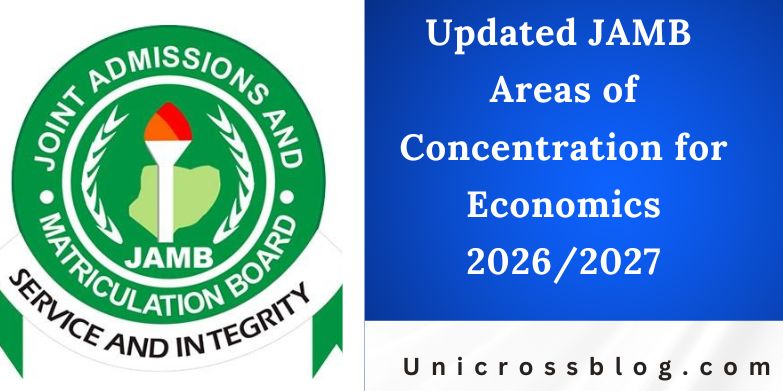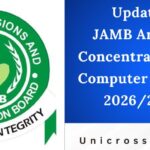The Joint Admissions and Matriculation Board (JAMB) examination is a pivotal gateway for Nigerian students aspiring to higher education. For the 2026/2027 session, the Updated JAMB Areas of Concentration for Economics serves as a vital roadmap for candidates. This guide outlines the core topics and subtopics that form the foundation of the Economics paper in the Unified Tertiary Matriculation Examination (UTME). Designed to align with the official syllabus, it emphasizes conceptual understanding, analytical skills, and practical applications relevant to Nigeria’s economic landscape.
Economics in JAMB tests candidates’ grasp of fundamental principles, from microeconomic theories of individual and firm behavior to macroeconomic concepts like national income and international trade. The areas of concentration are structured to build progressive knowledge, starting with basic economic tools and advancing to contemporary issues such as development policies and resource management. With the exam typically comprising 50 objective questions, mastering these areas can significantly boost scores, especially for students targeting competitive courses in accounting, business administration, finance, or economics itself.
This updated version for 2026/2027 reflects minor refinements based on evolving educational standards, including greater emphasis on data analysis and sustainable development. Candidates are encouraged to study these topics holistically, integrating real-world Nigerian examples like inflation trends or agricultural policies. By focusing here, you avoid wasting time on peripheral content and sharpen your problem-solving abilities.

JAMB Areas of Concentration for Economics
1. Economics as a Science
Economics is viewed as both a social science and an art, relying on systematic observation and logical reasoning. Key concepts include the nature of economic problems, such as scarcity and choice, and the scientific method in economics, which involves hypothesis formulation, data collection, and empirical testing. Understand the positive (fact-based) versus normative (value-based) aspects of economic statements.
Objectives: Differentiate economics from other sciences and appreciate its role in policy-making. Study tips: Review historical contributions from economists like Adam Smith and Karl Marx. Practice identifying economic hypotheses in Nigerian contexts, such as resource allocation in oil-dependent economy.
2. Economic Systems
Explore the spectrum of economic systems: traditional, command, mixed, and market-oriented. Focus on resource allocation mechanisms, ownership of factors of production, and incentives in each system. Nigeria’s mixed economy blends private enterprise with government intervention in sectors like petroleum.
Objectives: Analyze strengths and weaknesses of systems and their applicability to developing nations. Study tips: Compare capitalist features in the USA with socialist elements in Cuba. Use diagrams to illustrate resource flows in Nigeria’s system.
3. Methods and Tools of Economic Analysis
Master basic tools like tables, graphs (demand/supply curves), and equations for elasticity calculations. Cover descriptive statistics, such as means and medians, and introductory econometrics concepts like correlation versus causation.
Objectives: Apply tools to interpret economic data accurately. Study tips: Practice sketching indifference curves and budget lines. Solve problems on price elasticity using Nigerian commodity prices, like rice or fuel.
4. The Theory of Demand
Delve into the law of demand, determinants (income, tastes, prices of related goods), and exceptions like Giffen goods. Cover movements along versus shifts in demand curves.
Objectives: Predict consumer responses to price changes. Study tips: Calculate income and cross elasticities with examples from Nigerian markets, such as mobile phone demand amid rising incomes.
5. The Theory of Consumer Behaviour
Examine utility maximization through marginal utility theory and indifference curve analysis. Discuss budget constraints and the substitution/income effects.
Objectives: Explain how consumers allocate limited resources. Study tips: Draw Lorenz curves for income distribution in Nigeria. Analyze behavioral economics insights, like why subsidies on essentials alter choices.
6. The Theory of Supply
Understand the supply law, determinants (technology, input costs), and shifts versus movements. Include joint and competitive supply concepts.
Objectives: Forecast producer reactions to market signals. Study tips: Use Nigerian cocoa farming to illustrate cost-driven supply changes. Practice graphing supply schedules.
7. The Theory of Price Determination
Focus on market equilibrium, surplus/shortage, and price controls like minimum wage or subsidies. Cover cobweb theory for dynamic adjustments.
Objectives: Analyze how prices coordinate supply and demand. Study tips: Simulate equilibrium for Nigerian naira-dollar exchange. Discuss impacts of fuel price deregulation.
8. The Theory of Production
Cover production functions, stages of production (increasing/decreasing returns), and isoquants. Include division of labor and specialization.
Objectives: Evaluate efficient input combinations. Study tips: Apply to Nigerian manufacturing, like textile industries. Calculate marginal product from data tables.
9. Theory of Costs and Revenue
Differentiate fixed/variable costs, short/long-run averages, and marginal costs. Explore revenue concepts: total, average, marginal, and elasticity of demand affecting revenue.
Objectives: Advise firms on profit maximization where MR = MC. Study tips: Graph cost curves for a Nigerian SME. Analyze breakeven points in agriculture.
10. Market Structures
Compare perfect competition, monopoly, monopolistic competition, and oligopoly. Discuss barriers to entry, price/output decisions, and efficiency losses.
Objectives: Assess welfare implications of structures. Study tips: Relate to Nigerian telecom oligopoly (MTN, Airtel). Use game theory for price wars.
11. National Income
Define GDP (nominal/real), GNP, NNP, and measurement methods (expenditure, income, value-added). Cover circular flow of income.
Objectives: Compute national income aggregates. Study tips: Use Nigeria’s NBS data for GDP calculations. Discuss informal sector underestimation.
12. Money and Inflation
Explain money functions, types (M1, M2), and quantity theory. Analyze inflation causes (demand-pull, cost-push), measurement (CPI), and effects.
Objectives: Evaluate monetary policy tools like open market operations. Study tips: Track Nigeria’s hyperinflation episodes. Calculate inflation rates from price indices.
13. Financial Institutions
Overview of central bank (CBN), commercial banks, microfinance, and capital markets. Discuss roles in liquidity provision and regulation.
Objectives: Understand intermediation and financial stability. Study tips: Examine CBN’s cashless policy impacts. Compare with IMF influences.
14. Public Finance
Cover government revenue (taxes, grants), expenditure (recurrent/capital), and budgets. Analyze fiscal policy, deficits, and public debt.
Objectives: Assess fiscal tools for stabilization. Study tips: Review Nigeria’s VAT hikes. Discuss debt sustainability ratios.
15. Economic Growth and Development
Differentiate growth (GDP increase) from development (HDI, poverty reduction). Cover sources (capital, labor, technology) and policies (import substitution).
Objectives: Propose strategies for Nigeria’s SDGs. Study tips: Analyze Vision 2050 goals. Compute growth rates from time-series data.
16. Agriculture in Nigeria
Examine contributions (GDP share, employment), challenges (climate, funding), and policies (Operation Feed the Nation, Anchor Borrowers).
Objectives: Evaluate modernization paths. Study tips: Discuss cassava value chains. Assess export potentials like sesame.
17. Industry and Industrialization
Overview of manufacturing, mining, and services. Cover strategies (backward integration), challenges (power shortages), and NEPAD roles.
Objectives: Promote industrial diversification. Study tips: Study Ajaokuta Steel’s failures. Analyze SEZs impacts.
18. Natural Resources and the Nigerian Economy
Focus on oil (resource curse), solid minerals, and renewables. Discuss rent-seeking and diversification.
Objectives: Balance extraction with sustainability. Study tips: Calculate resource rents. Explore gas flaring penalties.
19. Business Organizations
Types: sole proprietorship, partnership, companies (private/public). Cover cooperatives and multinationals.
Objectives: Choose optimal structures. Study tips: Compare Dangote Group’s evolution. Discuss liability risks.
20. Population
Theories (Malthusian, demographic transition), census issues, and migration. Link to labor supply and dependency ratios.
Objectives: Analyze population policies. Study tips: Use Nigeria’s 2006 census projections. Discuss youth bulge opportunities.
21. International Trade
Comparative advantage, terms of trade, and balance of payments. Cover tariffs, quotas, and WTO.
Objectives: Evaluate trade liberalization. Study tips: Compute Nigeria’s trade deficits. Analyze AfCFTA benefits.
22. International Economic Organizations
Roles of IMF, World Bank, ECOWAS, and AU in aid, loans, and integration.
Objectives: Assess development finance. Study tips: Review structural adjustment programs’ legacies. Discuss climate funds.
23. Factors of Production and Their Theories
Land, labor, capital, entrepreneur. Theories: marginal productivity, wage determination.
Objectives: Allocate factors efficiently. Study tips: Apply to Nigerian informal labor markets. Discuss entrepreneurship incentives.
READ ALSO: Updated JAMB Areas of Concentration for Mathematics 2026/2027
FAQs
What is the format of the JAMB Economics exam for 2026/2027?
The exam consists of 50 multiple-choice questions to be answered in 40 minutes, delivered via computer-based testing (CBT).
How has the Economics syllabus changed for 2026/2027?
Updates include enhanced focus on sustainable development and digital financial tools, but core topics remain consistent with prior years.
What score should I aim for in Economics?
Target at least 60% (30/50) for competitive admissions, though top universities prefer 70% or higher.
Are past questions sufficient for preparation?
No, combine them with textbook studies on these areas for deeper understanding.
Can I use calculators during the exam?
No, but basic computations are designed to be mental or simple.
How do I apply these areas to Nigerian contexts?
Relate theories to local issues, like using demand theory for subsidy removals, to make studies relevant.







